Abstract
Nemertean worms contain toxins that are used to paralyze their prey and to deter potential predators. Hoplonemerteans often contain pyridyl alkaloids like anabaseine that act through nicotinic acetylcholine receptors and crustacean chemoreceptors. The chemical reactivity of anabaseine, the first nemertean alkaloid to be identified, has been exploited to make drug candidates selective for alpha7 subtype nAChRs. GTS-21, a drug candidate based on the anabaseine scaffold, has pro-cognitive and anti-inflammatory actions in animal models. The circumpolar chevron hoplonemertean Amphiporus angulatus contains a multitude of pyridyl compounds with neurotoxic, anti-feeding, and anti-fouling activities. Here, we report the isolation and structural identification of five new compounds, doubling the number of pyridyl alkaloids known to occur in this species. One compound is an isomer of the tobacco alkaloid anatabine, another is a unique dihydroisoquinoline, and three are analogs of the tetrapyridyl nemertelline. The structural characteristics of these ten compounds suggest several possible pathways for their biosynthesis.
1. Introduction
Hoplonemerteans (also called hoplonemertines) are a class of mostly marine worms belonging to the phylum Nemertea that capture their prey with a venomous proboscis. Their name is derived from the Greek word Hoplos meaning “armed”. Bacq discovered the presence of toxins in nemerteans [1,2]. Extracts of several hoplonemertean species activate cholinergic synapses, such as the neuromuscular junction and autonomic ganglia. He postulated that these activities were due to the presence of a compound that he named “amphiporine” after Amphiporus lactifloreus (Al), the most thoroughly investigated species. Al extracts were chemically and pharmacologically similar to the alkaloid nicotine. Alkaloid purification at that time was largely based on fractional crystallization with picric or other acids to form sparingly soluble salts. A picrate salt was obtained from Al but in an amount insufficient for structural analysis [3].
Three decades later, several hoplonemertean species were shown to contain pyridyl alkaloids with chemical and pharmacological properties similar to amphiporine. Anabaseine, 2-(3-pyridyl)-3,4,5,6-tetrahydropyridine (Figure 1) was the first nemertean alkaloid to be chemically identified [4,5]. Large amounts of anabaseine were found in the proboscis and body integument of the peregrine nemertean, Paranemertes peregrina, a relatively common hoplonemertean along the Pacific coasts of the USA and Canada [6]. Anabaseine is of considerable pharmacological interest as it is a potent nicotinic acetylcholine receptor agonist, though relatively unselective for a particular nAChR subtype [7,8]. An anabaseine derivative (GTS-21) selectively activates alpha7 nAChRs and has been the subject of several clinical tests as a potential drug for treating Alzheimer’s disease and schizophrenia [9,10,11]. GTS-21 has also become a favorite chemical tool for investigating the involvement of the alpha7 nicotinic acetylcholine receptor (nAChR) in cognition and other processes including inflammation due to its selective activation of this receptor subtype and ability to enter the brain [12,13,14].
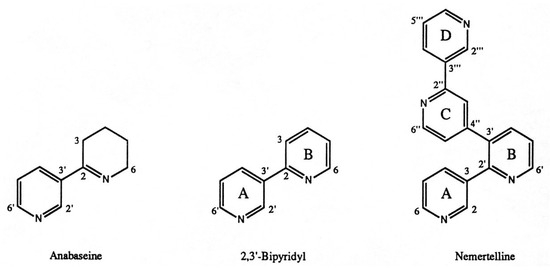
Figure 1.
Structures of three previously identified pyridyl alkaloids of Amphiporus angulatus. A fourth Aa alkaloid, 3-methyl-2,3′-BP, has the same structure as 2,3′-BP, except that a methyl group is attached at the 3 position. Notice nomenclature for positions on rings A to D in nemertelline.
The initial studies on nemertean toxins focused on abundant, relatively large, and easily collected species so that sufficient quantities of toxins could be isolated for structural and pharmacological characterization. One of the largest hoplonemertean species available to us was the chevron nemertean Amphiporus angulatus (Aa, Figure 2), which has a circumpolar distribution from the New England Atlantic coast north to Iceland then west through the NW passage of Canada and south along the northern American Pacific coasts. The two most abundant alkaloids (Figure 1) of this species, 2,3′-bipyridyl (2,3′-BP) and the tetrapyridyl nemertelline, were isolated via preparative layer chromatography and identified via mass spectrometric (MS) and nuclear magnetic resonance (NMR) analyses [15]. Nemertelline was so named because it is structurally similar to the tobacco alkaloid nicotelline, a tripyridyl which lacks the A ring of nemertelline. Only small amounts of anabaseine are present in Aa. The fourth Aa alkaloid to be identified was the volatile 3-methyl-2,3′-BP [16]. Both BPs potently paralyze crustaceans, which are thought to be the major prey of this hoplonemertean. Nemertelline displays a weak paralytic activity when injected into crayfish, but none when injected into mice. All of these pyridyls activate crustacean chemoreceptors involved in the recognition of potential prey [17]. They also inhibit barnacle larvae settlement (biofouling) and therefore have potential as commercial biofouling inhibitors [18,19].
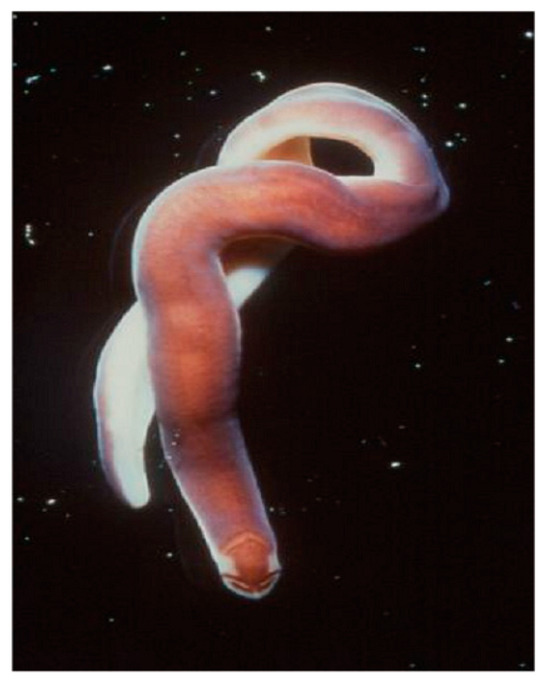
Figure 2.
The bottom-dwelling chevron nemertean Amphiporus angulatus lives under rocks within the intertidal zone and in shallow water at northern latitudes. It feeds upon small crustaceans, which it paralyzes with a venomous proboscis. It is readily identified by the white chevron pattern on its neck, a purple dorsal surface, and white ventral surface. Adults can attain a length of 10 cm and fresh weight of 2 g. (Photograph courtesy of N. A. Meinkoth.).
Other pyridyl alkaloids were detected in the initial Aa alkaloid investigations but could not be purified via conventional low pressure liquid chromatographic methods in sufficient amounts for structural identification with the MS and NMR instruments available at that time. However, we were eventually able to collect several hundred members of this nemertean species, enabling the isolation and structural identification of additional alkaloids, which are the subjects of this article.
2. Results
2.1. Bipyridyl Compounds
A GC-EIMS analysis (Figure 3) of the Aa extract basic chloroform phase revealed numerous (>20) peaks, most of which appeared, from their EI mass spectra, to be pyridyl alkaloids. The initial cluster of peaks was found to be due to bipyridyl-type alkaloids with different degrees of 2-pyridyl ring saturation. The dominant peak 3 was due to 2,3′-BP. The GC peak 1 molecular ion was m/z 162; its HPLC retention time and 70 eV EI fragmentation spectrum were essentially identical to those of the tobacco alkaloid anabasine, already known to occur in some hoplonemerteans [20] and ants [21].
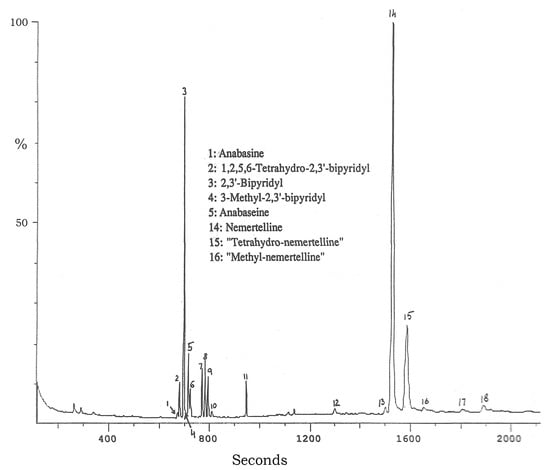
Figure 3.
GC-MS profile of the Aa extract basic chloroform phase alkaloids. Compounds in peaks 6–13 were not identified. The peak 15 compound, a tetrahydronemertelline, was the third-most-abundant compound.
The GC peak 2 molecular ion was m/z 160, the same as for anabaseine (peak 5). However, its EIMS fragmentation spectrum (Table 1) was distinctly different from those of anabaseine and the tobacco alkaloid anatabine, but nearly identical to the EIMS data for the anatabine isomer 1,2,5,6-tetrahydro-2,3′-bipyridyl [22,23]. The elemental composition of the peak 2 compound (See bottom of Figure 4) was the same as that of anatabine, 1,2,5,6-tetrahydro-2,3′-bipyridyl and anabaseine.

Table 1.
Comparison of the GC-EI-MS peak 2 compound with synthetic 1,2,5,6-tetrahydro-2,3′-bipyridyl (isoanatabine) and anatabine. Fragment amplitude is expressed as percent of base peak. M+. is abbreviated to M.

Figure 4.
Isoanatabine: structure, proton NMR assignments, and high-resolution-EI-MS-determined elemental composition. See NMR spectrum in Supplementary Materials (page S1).
Conventional silica gel or aluminum oxide chromatography of the Aa extract basic chloroform phase compounds revealed a multitude of putative pyridyl alkaloid peaks, with 2,3′-BP and nemertelline, again, being the most abundant. Most previously identified compounds, including anabaseine, anabasine, 2,3′-BP, 3-Me-2,3′-BP, and nemertelline, could be tentatively recognized through their UV absorbance spectra. Approximately 1.6 mg of the compound corresponding to the GC-MS peak 2 was obtained via conventional normal-phase SG column chromatography; this was sufficient to acquire a proton NMR spectrum (Supplementary Materials, page S1); see Figure 4 for a summary of the data. The aromatic proton peaks revealed the presence of a single 3-pyridyl moiety with signals essentially identical to those of the tobacco alkaloid anabasine. Protons from the other ring included two olefinic multiplet proton signals at 6.02 and 5.72 ppm, both with coupling constants of 10.2 Hz, indicating the presence of a cis double bond. An apparent quintet at 4.55 ppm with a 2.5 Hz coupling constant was assigned as a methine proton with neighboring aromatic ring, NH, and olefin groups. The multiplet lines at 2.05–2.35 and 2.96–3.15 ppm, each with two proton intensities, were assigned as methylenes next to an olefinic bond and a nitrogen atom, respectively. These interpretations are in good agreement with the structure shown in Figure 4. Direct comparisons of the NMR and MS spectra of the Aa alkaloid free base and the synthetic 1,2,5,6-tetrahydro-2,3’-bipyridyl free base, generously provided by Prof. L. Overman, demonstrated that they were the same coupound [21,22]. We named it isoantabine [23], as it is isomeric with anatabine and differs only slightly in the position of the piperidinyl ring double bond (between carbons at 3 and 4, instead of 4 and 5 as in anatabine). HPLC-MS examination of the Aa extract alkaline chloroform phase mixture also indicated the presence of a very small peak 4 alkaloid with m/z 170 M+. Its amount relative to the 2,3′-BP peak content was estimated to be <1%. Its EI-MS spectrum was in good agreement with that of 3-methyl-2,3′-BP [16]. The NMR spectrum of the isolated 2,3′-BP fraction contained a small singlet at 2.39 ppm. By adding a trace amount of this fraction to samples containing one of the eight possible methyl-2,3′-BP isomers prepared for pharmacological studies, it was found that this signal was only at the same position in the 3-methyl-2,3′-BP isomer. Further analyses led to its identification as 3-methyl-2,3′-BP [17]. Later, it was observed that the amount of this volatile compound in Aa crude extracts was much higher (~25% of 2,3′-BP) when the organic solvent evaporations were carried out below 30 °C.
2.2. Angulatine, A Novel Dihydroisoquinoline Alkaloid
Although it was unstable under GC-EI-MS conditions, this compound was detected when the LC-ESI-MS analysis of Aa alkaloids revealed a compound with an m/z 344 [M + H]+ ion corresponding to a free base MW = 343. It was eventually isolated from the Aa extract basic chloroform phase via repeated SG column chromatography under basic conditions. The resulting 2.5 mg sample was exhaustively examined via COSY, NOESY, HMQC, HMBC, and TOCSY NMR protocols. The structure of the free base was revealed via the NMR analyses to be a trisubstituted dihydroisoquinoline (Figure 5). High resolution mass spectrometry indicated that its empirical formula was C22H21N3O. Its proton NMR spectrum clearly indicated the presence of two 3-pyridyl moieties and two aromatic singlets at 7.39 and 7.24 ppm in the aromatic region, while in the aliphatic region there was a methylene singlet at 4.25 ppm, two methylene doublet-doublets at 3.97 and 2.92 ppm and resonances of an ethoxy group. Using decoupling experiments we determined which lines belong to the individual 3-pyridyl rings, and that the two methylene doublet-doublets are coupled with each other. The TOCSY spectrum revealed small and/or long-range couplings among the two aromatic singlets, the methylene singlet and the two methylene doublet-doublets (See Supplementary Materials, pages S2–S5). While the positions of the proton resonances in one of the 3-pyridyl rings were very similar to those in the 3-pyridyl ring of anabaseine, the resonances due to the other 3-pyridyl ring were more similar to the pyridyl resonances of 3-phenyl-pyridine. The position of the methylene singlet indicated that the methylene and ethoxy groups constitute an ethoxymethylene moiety connected to an aromatic ring. The position and the shape of the two methylene doublet-doublets were characteristic of those found in other 3,4-dihydroisoquinolines. Two possible structures were consistent with these assignments. NOE experiments carried out to distinguish between them clearly revealed the proximity of the “doublet-doublet” methylene hydrogens at 2.85 ppm to the pyridyl singlet at 7.24 ppm and the proximity of the “singlet” methylene hydrogens at 4.25 ppm to the aromatic proton at 7.39 ppm. These data identified the Aa compound as 1,6-di(pyrid-3-yl)-7-ethoxymethyl-3,4-dihyroisoquinoline. To our knowledge, this is the first time that a 3,4-dihydroisoquinoline alkaloid of this type has been found in nature.
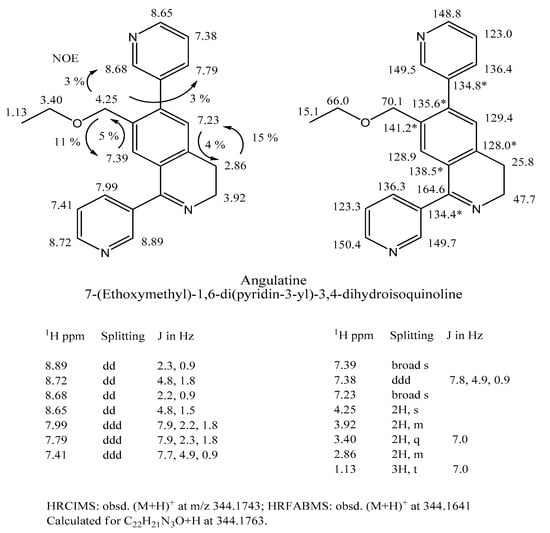
Figure 5.
Angulatine structure, with proton and carbon NMR assignments. Its elemental composition was determined via HR-CI-MS and HR-FAB-MS. Additional NMR spectral data can be found in the Supplementary Materials, pages S2–S5.
2.3. New Nemertellines
The initial GC-EIMS analysis (Figure 3) of the crude basic chloroform phase fractionrevealed the presence of several compounds with masses similar to nemertelline (free base m/z 310). These were subsequently isolated via SG chromatography. The most abundant nemertelline analog (m/z 314 M+.) displayed an EIMS fragmentation pattern similar to nemertelline (Table 2). It was shown via extensive NMR analyses to have the same ring connections as nemertelline. The additional four hydrogens were located in the C ring (Figure 6). The structure of this compound, named tetrahydronemertelline, was determined via multi-dimensional NMR methods (see Supplementary Materials pages S6–S21 for the NMR data).

Table 2.
Comparison of the GC-EI-MS spectra of the four Aa nemertellines. The molecular ion M+. is abbreviated as M. Fragment amplitude is expressed as percent of base peak. Dashes indicate a fragment abundance relative to base peak of 0–10%. The elemental compositions of all four compounds were consistent with their names. Ions generated via a common mass loss are highlighted in red.
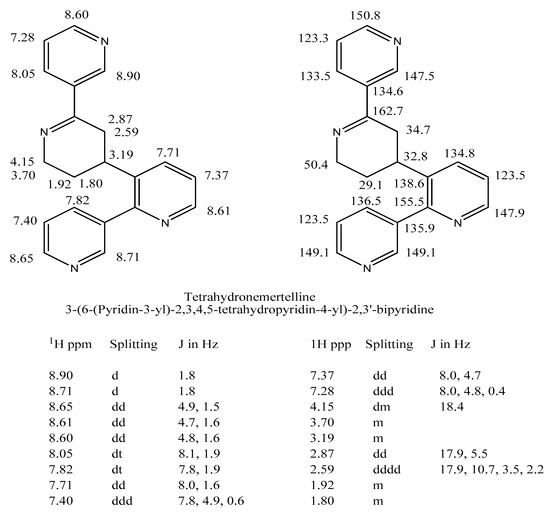
Figure 6.
Tetrahydronemertelline structure and the NMR spectroscopic data used for its identification. Additional proton and 13C NMR spectral data can be found in the Supplementary Materials (pages S6–S21).
Insufficient amounts of methylnemertelline and hydroxynemertelline were obtained for the unequivocal identification of their structures, but, since their EIMS fragmentation patterns (Table 2) were similar to nemertelline, we suspect that these methyl and hydroxy substituents are located at the nemertelline C ring 3 position.
2.4. Two DehydroNemertellines
Two isomeric nemertelline derivatives with identical m/z 308 molecular ions and common (but unique) UV absorbance spectra were observed to elute before nemertelline when isolated as free bases via normal phase SG LC in the presence of diethylamine. NMR analyses (including the HMBC and HSQC spectral determinations of 13C peaks; see Supplementary Materials pages S22–S31) showed that they have the same basic inter-ring connectivity as nemertelline, but the 2- or 4-position hydrogen in the A ring has been replaced with a carbon–carbon bond with the 5” carbon in ring C (Figure 7). Unlike nemertelline, these two compounds displayed two additional small (~20% magnitude relative to their peak absorbance at 260 nm) absorbance peaks at 330 and 345 nm. Space-filling molecular models of the two dehydronemertellines compounds allowed the co-planarity of the A ring with the C and D rings, whereas, in nemertelline, the A ring was twisted out of the plane of the B and C rings.
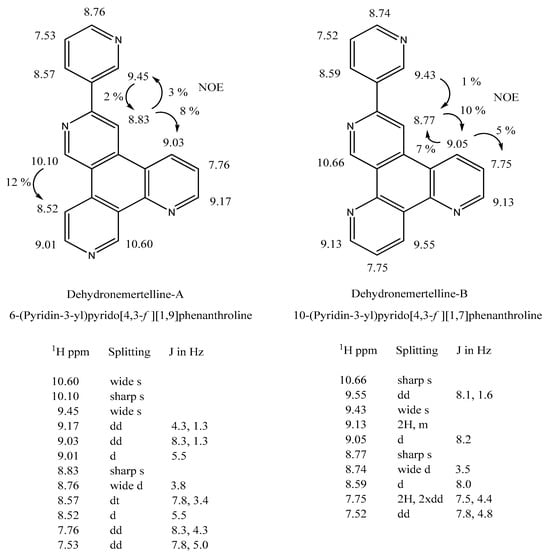
Figure 7.
Structures of Aa dehydronemertellines A and B and proton NMR data used for the structure determination. See Supplementary Materials pages S22–S31 for additional NMR data, including for 13C resonances. S31 has a table of proton-carbon correlations for each dehydronemertelline.
Although the 13C chemical shifts for nemertelline have been reported [24,25], the positions of the carbons in the nemertelline structure were not assigned. Therefore, we carried out such correlations and have assigned 13C values to 19 of the 20 carbons present (see Supplementary Materials pages S32–S37 for the spectra and table). This new data should aid in the interpretation of data for related compounds in future studies. Also, they indicate that the addition of the additional C-C bond between rings A and C in the two dehydronemertellines produces considerable changes in the chemical shifts of carbons and protons in the A, B, and C rings of these two compounds relative to nemertelline.
3. Discussion
3.1. Functional Considerations
The remarkable number of pyridyl alkaloids in this species needs to be discussed. Aa is a relatively large benthic (bottom-dwelling) hoplonemertean. It cohabits the crevices under rocks in the lower intertidal zone and below with a variety of other organisms. It is thought to primarily feed on amphipod crustaceans, which it paralyses with its proboscis venom apparatus. It must also deter the predatory crabs, fish (blennies), mollusks, and other animals that occupy the same space. 2,3′-BP, the most abundant bipyridyl alkaloid, potently (and rapidly) paralyses crayfish upon injection into their vascular system and is even more potent (~4×) than anabaseine. However, this alkaloid does not paralyze mice at doses 50× the LD50 of anabaseine [15].
The ecological function of nemertelline, the most abundant pyridine alkaloid, is still unclear as it is only moderately toxic to crustaceans and its anti-fouling activity does not exceed that of 2,3′-BP. Since the environment of this hoplonemertean undoubtedly contains many potentially infective micro-organisms, it seems possible that nemertelline and its congeners may have antimicrobial activity. Nemertelline is readily synthesized via two different methods [24,25], so testing for antimicrobial activity should be feasible.
While 2,3′-BP and 3Me-2,3′-BP have only a mild paralytic activity on mice and a weak interaction with nicotinic acetylcholine receptors, the vertebrate-active components of Aa (isoanatabine, anabasine, and anabaseine) have complementary properties relative to the BPs. The first two compounds have one highly basic secondary amine nitrogen, which allows a greater fraction of the molecules to be in the active, ionized form at a physiological pH [26,27]. Anabaseine has a wide spectrum of nAChR activity in vertebrates as well as invertebrates. Interestingly, it was found to be concentrated in the Aa median proboscis, which also contains the stylet apparatus (Kem, unpublished results). This suggests that its primary function is the paralysis of prey. As might be expected, isoanatabine and anatabine have very similar pharmacological properties and are relatively potent toxins to vertebrates. The two enantiomers of isoanatabine also exhibit similar pharmacolgical profiles on the two most abundant mammalian brain nicotinic receptors [28]. In the present investigation, we measured the circular dichroism spectrum of natural isoanatabine but failed to find optical activity, a measure of the prevalence of one enantiomer over the other.
The occurrence of a dihydroisoquinoline alkaloid like angulatine in an animal is unusual. While plants make a wide variety of pharmacologically active isoquinolines, few of these compounds have been isolated from marine animals. Imbricatine, a sea star tetrahydroisoquinoline, may be the first marine compound of this type that has been reported [29]. There are also isoquinoline compounds in certain sponges, aptamines, that have been found to exert a variety of pharmacological actions on the nervous system, as well as having anti-cancer activities [30,31,32]. Angulatine has unusual substituents on the aromatic portion of its dihydroisoquinoline ring, making it rather unique and difficult to synthesize using traditional methods. Our attempts to synthesize angulatine have not been successful, probably because the 6- and 7-position substituents are not sufficiently electron-donating to facilitate the final ring-closing step (a Pictet–Spengler reaction). We had insufficient amounts of this natural product to assess its toxicity beyond showing that it potently paralyzes crayfish, which are usually quite sensitive to compounds like nicotine and anabaseine with cholinergic system activity. A compound containing three of the four rings in angulatine was synthesized but, apparently, was not pharmacologically tested [33].
3.2. Possible Pathways for Hoplonemertean Alkaloid Biosynthesis
Anabasine is the dominant alkaloid in certain tobacco plant species. In fact, the alkaloid’s name comes from the tobacco genus Anabasis. As previously mentioned, several species of hoplonemerteans and ants also contain significant amounts of anabasine as well as anabaseine. Leete [34] extensively investigated the biosynthetic pathways for anabasine, anatabine, and nicotine in various tobacco species. The 3′-pyridyl rings in nicotine and anabasine were found to derive from nicotinic acid. The sources of the pyrrolidinyl and tetrahydropyridyl rings in these two compounds were, respectively, N-methyl putrescine and lysine. According to Leete [35], both rings of anatabine may originate from lysine. Our speculation concerning the biosynthesis of the Aa pyridyl alkaloids is partly based on these plant studies and the observation that the peripheral 3-substituted pyridyl rings in all known hoplonemertean alkaloids are always free of other substituents. We suggest (Figure 8) that the hoplonemertean 3-pyridyl rings originate from nicotinic acid or nicotinamide and that the 2- substituted rings in the bipyridyls and the internal pyridyl rings in nemertellines are derived either from another nicotinate or lysine or from the sequential attachment of short chain fatty acids such as acetate, malonate, or propionate to an activated nicotinic acid (thioester?) moiety. Experiments with labelled potential precursors may be useful in delineating the biosynthetic pathway for these hoplonemertean alkaloids. The biosynthesis of nemertelline and its congeners seems very likely to result from a hetero-dimerization of anabaseine (providing the A and B rings of nemertelline) with an activated precursor of isoanatabine (providing the C and D rings of the tetrapyridyl, as shown in Figure 9). The postulated 3′’-methyl-nemertelline and 3′’-hydroxy-nemertelline (see Figure 1 for the numbering of ring atoms) could be biosynthesized via the reaction of 2-(3′-pyridyl)-3-methyl-1,2,5,6-tetrahydropyridyl (MW 174) or 2-(3′-pyridyl)-3-hydroxy-1,2,5,6-tetrahydropyridyl (MW 176) precursors with anabaseine, respectively. Preliminary evidence for the presence of these two postulated BP precursors of nemertelline was obtained during GC-MS and LC-MS analyses of the crude extract basic chloroform phase.
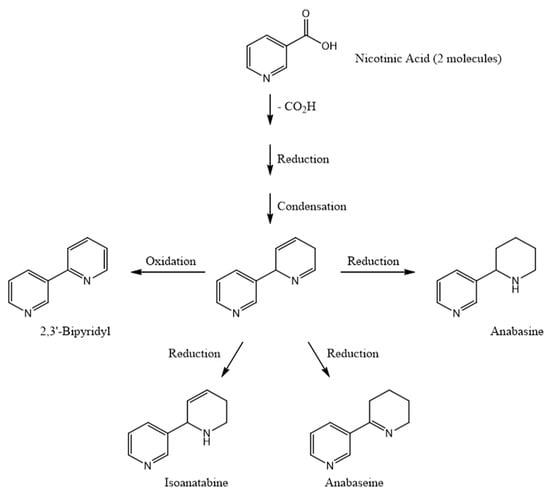
Figure 8.
Possible pathway for biosynthesis of nemertean pyridyl alkaloids starting with nicotinic acid.
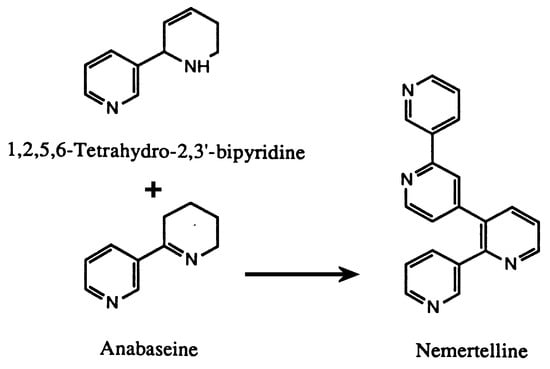
Figure 9.
Possible biosynthetic pathway for nemertelline. An activated form of isoanatabine precursor could react with the electronegative carbon at position 3 of the tetrahydropyridyl ring of anabaseine.
Several papers have been published in recent years reporting transcriptomic investigations into various nemerteans [36,37,38,39]. These investigations only searched for peptidic toxins. Several decades ago, three types (MWs of 20,000, 6000, and 3500) of peptidic toxins were isolated from pilidiophoran (formerly called heteronemertean) species [40,41,42,43]. While hoplonemerteans have only been demonstrated to contain alkaloid toxins, the transcriptomic data suggested the presence of other peptidic toxins in this group. These inferences need to be substantiated by isolating and pharmacologically characterizing the putative toxins. Hopefully, future “ohmics” studies on hoplonemerteans will also search for the genes of enzymes that might be involved in the biosynthesis of the various hoplonemertean pyridyl alkaloids. Enzymic candidates include lysine decarboxylases, cytochrome P450s, imine reductases, methyl transferases, and enzymes associated with fatty acid oxidation.
The delineation of the pyridyl biosynthetic pathway(s) would not only shed light on the evolution of this toxin family but could also ultimately provide a means to biosynthesize artificial, as well as natural, pyridine alkaloids of pharmacological interest that might be difficult to obtain from nature in sufficient quantities for pharmacological investigations. Finally, it will also be interesting to determine whether the alkaloid biosynthesis is performed by worm enzymes or by enzymes produced by bacterial endo-symbionts.
4. Concluding Remarks
The presence of a relatively large number (probably >15) of pyridyl compounds in Aa is a strong indication that at least some species in the class Hoplonemertea contain a remarkable chemical diversity of pyridine alkaloids, perhaps exceeding the alkaloid diversity previously observed in tobacco plants. Other pyridine alkaloids undoubtedly occur in Aa, but their NMR spectra could not be obtained with the limited amounts available. These include an MW 174 compound, possibly a 3-methyltetrahydropyridyl ring precursor of 3-methyl-2,3′-BP. Also, a compound was detected that may be an angulatine analog that lacks one methylene group within the 7-ethoxy-methylene sidechain. We will attempt to identify these and other interesting compounds in the future if more chevron nemerteans can be collected. The identification of additional alkaloids in this and other hoplonemerteans could assist in suggesting possible biosynthetic relationships between the compounds, as well as provide compounds with novel pharmacological activities.
5. Materials and Methods
5.1. Animal Collection
Altogether, two hundred (175 g fresh weight) A. angulatus worms were collected at exceptionally low tides along the Maine side of Passamaquoddy Bay, near Eastport, Maine. The live worms were initially placed in polyethylene bottles containing approximately 10 volumes (per fresh weight) of ethanol containing 1% acetic acid. The bottles were transported to Florida at ambient temperatures, then stored at −20 °C prior to alkaloid analyses.
5.2. Alkaloid Extraction and Purification
After removing the acidic ethanol preservative, the preserved worms were extracted with an additional 0.8 L of acidic ethanol, yielding a cumulative volume of 2.6 L acidic ethanol solution. This was filtered and evaporated under vacuum at room temperature, yielding a syrup. To this partially particulate residue (25.2 g), 60 mL water and 120 mL chloroform were added. The pH was then brought to 1.5 with concentrated hydrochloric acid. This was hand-shaken in a separatory funnel. After standing overnight at room temperature, the two phases were separated and the acidic aqueous phase was again extracted with 2 × 120 mL chloroform. The pH of the separated aqueous phase was brought to 12 with ice-cold 40% sodium hydroxide, and then 100 mL dichloromethane was added to extract the basic compounds. After shaking and standing, the resulting interfacial suspension was broken down via centrifugation and the acidic aqueous phase was re-extracted with 5 × 100 mL dichloromethane. The combined basic organic solutions were dried over magnesium sulfate and rotary-evaporated under vacuum at 20 °C, yielding 0.56 g of oily crude alkaloid extract. Column chromatography using 50 g of silica gel with ether-diethylamine (9:1, v/v) development provided several fractions: 67 mg of crude 2,3′-BP fraction, 12 mg of an intermediate fraction, 206 mg of a crude nemertelline fraction, and 241 mg of the most polar alkaloids. The 2,3′-BP fraction was further purified via column chromatography on 20 g silica gel developed with cyclohexane-diethylamine (8:2, v/v), giving 32 mg of purified 2,3′-bipyridyl, which was examined for its methyl-2,3′-bipyridine content.
5.3. Gas Chromatographic Analysis of the Crude Alkaloid Fraction
To resolve and identify the different Aa alkaloids, GC-EIMS measurements utilized a 3 m length 0.25 mm i.d. 5% phenylmethylpolysiloxane (DB-5MS, J & W Scientific, Folsom, CA, USA) capillary column with oven temp of 300 °C.
5.4. LC-MS Analyses
A reverse-phase HPLC-(+)ESI-MS analysis of the chloroform extracted compounds was performed on a Thermo Fisher Scientific (Waltham, MA, USA) LTQ classic quadrupole ion trap mass spectrometer operated in the positive electrospray ionization (ESI) mode. ESI-normal MS scans were taken, and data-dependent MS/MS scans were obtained on the most abundant ion of the preceding MS scan with a 4u-isolation window, 0.3 qCID, 42.5% normalized CID, and 30ms CID duration. Chromatography was performed with an Agilent (Santa Clara, CA, USA) 1100 series binary pump and a Waters (Milford, MA, USA) Xterra MS C18 (2.1 mm × 150 mm; 3.5 μm) with Phenomenex (Torrance, CA, USA) C18 Security Guard Column (2 mm × 4 mm). Mobile phase A was water plus 0.2% acetic acid, and mobile phase B was methanol with 0.2% acetic acid. With a flow rate of 0.15 mL/min, the gradient was 0%B (0 min) to 30%B at 15 min then to 95%B at 60 min and held for 20 min. An Agilent (Santa Clara, CA, USA) 1100 G1314A UV/Vis detector was positioned between the HPLC column and MS and monitored the HPLC effluent at 254 nm.
The time-of-flight high resolution mass spectrometry (TOF-HRMS) was performed on an Agilent (Santa Clara, CA, USA) 6220A time-of-flight HRMS interfaced to an Agilent 1100 binary HPLC. Flow injection analysis was used to introduce the sample. The TOF-HRMS was operated in the (+)ESI mode. Elemental composition of the DMAB-natural product was calculated with the Xcalibur Qual Browser Elemental Composition tool, Qual Browser, Thermo Fisher Scientific (Waltham, MA, USA) Xcalibur 2.2 SP1.48. CI-HRMS and FAB-HRMS analyses were performed by Cris Dancel.
5.5. NMR Spectroscopy
NMR spectra were acquired in CDCl3 on Varian Unity 300 MHz and Bruker Avance 500, 600, and 800 MHz spectrometers. The 600 MHz instrument was equipped with a unique 1-mm CryoProbe. Chemical shift axes in both proton and carbon spectra were referenced to internal tetramethylsilane at 0.0 ppm. The COSY (Correlation SpectroscopY), HSQC (Heteronuclear Single Quantum Coherence, with 1JCH set to 145 Hz), and HMBC (Heteronuclear Multiple Bond Correlation, with nJCH set to 8 Hz) spectra were acquired using conventional methods. NMR data for nemertelline was obtained on a sub-milligram quantity of the natural substance in a 3 mm tube with 180 µl of CDCl3 solution using the 800 MHz instrument’s 5 mm TCI CryoProbe. Spectra and spectral data of the five new compounds are to be found in the Supplementary Materials section.
Supplementary Materials
The following supporting information can be downloaded at: https://www.mdpi.com/article/10.3390/md22040141/s1, See pages S1–S37 for NMR data on the five new compounds and nemertelline.
Author Contributions
W.R.K.: conceptualization, methodology, alkaloid isolation, curation, writing and funding acquisition; F.S.: isolation and NMR data acquisition of bipyridyl compounds, data curation, writing; J.R.R.: methodology, NMR, NMR data acquisition, curation; J.V.J.: methodology, mass spectrometry data acquisition, curation. All authors have read and agreed to the published version of the manuscript.
Funding
This research was funded by Florida Sea Grant R/LR-MB-9 (W. Kem, P.I.). A portion of this work was performed in the McKnight Brain Institute at the National High Magnetic Field Laboratory’s Advanced Magnetic Resonance Imaging and Spectroscopy (AMRIS) Facility, which is supported by National Science Foundation Cooperative Agreement DMR-1157490 and the State of Florida. The MS data were obtained at the UF Chemistry Department Mass Spectrometry Research and Education Center funded by NIH S10 OD021758-01A1 and NIH S10 OD030250-01A1.
Institutional Review Board Statement
Not applicable.
Data Availability Statement
Additional NMR and MS data for identified compounds will be made available upon request.
Acknowledgments
The late Ferenc Soti (Kem Lab) isolated most compounds, acquired NMR spectra for the new compounds, curated data, and prepared a partial manuscript. The late Roy King carried out many of the initial GC-EIMS experiments. The late David Powell and Cris Dancel provided the CI-HRMS and FAB-HRMS analyses. The late Norman Meinkoth of Swarthmore College initially introduced the corresponding author to the New England marine fauna and showed him where to find Aa and other nemerteans in Maine. This paper is dedicated to these individuals and their service to science. Eric Kem assisted in preparing figures and, with James Scott, Reade Kem, and Robert Bosien, participated in numerous Aa collections at low tides in Passamaquoddy Bay near Eastport, Maine.
Conflicts of Interest
The authors declare no conflicts of interest.
References
- Bacq, Z.M. Les poisons des nemertiens. Bull. Cl. Sci. Acad. Roy. Belg. 1936, 22, 1072–1079. [Google Scholar]
- Bacq, Z.M. L”amphiporine” et la “nemertine,” poisons des vers nemertiens. Arch. Int. Physiol. 1937, 44, 190–204. [Google Scholar] [CrossRef]
- King, H. Amphiporine, an active base from the marine worm Amphiporus lactifloreus. J. Chem. Soc. 1939, 1365–1366. [Google Scholar]
- Kem, W.R. A Chemical Investigation of Nemertine Toxins. Ph.D. Dissertation, University of Illinois Urbana-Champaign, Champaign, IL, USA, 1969; pp. 1–113. [Google Scholar]
- Kem, W.R.; Abbott, B.C.; Coates, R.M. Isolation and structure of a hoplonemertine toxin. Toxicon 1971, 9, 15–22. [Google Scholar] [CrossRef] [PubMed]
- Kem, W.R. A study of the occurrence of anabaseine in Paranemertes and other nemertines. Toxicon 1971, 9, 23–32. [Google Scholar] [CrossRef]
- Kem, W.R.; Mahnir, V.M.; Papke, R.; Lingle, C. Anabaseine is a potent agonist upon muscle and neuronal alpha-bungarotoxin sensitive nicotinic receptors. J. Pharmacol. Exp. Ther. 1997, 283, 979–992. [Google Scholar] [PubMed]
- Kem, W.R.; Soti, F.; Wildeboer, K.; LeFrancois, S.; MacDougall, K.; Wei, D.-Q.; Chou, K.-C.; Arias, H.R. The nemertine toxin anabaseine and its derivative DMXBA (GTS-21): Chemical and pharmacological properties. Mar. Drugs 2006, 4, 255–273. [Google Scholar] [CrossRef]
- Kitagawa, H.; Takenouchi, T.; Azuma, R.; Wesnes, K.A.; Kramer, W.G.; Clody, D.E.; Burnett, A.L. Safety, pharmacokinetics, and effects on cognitive function of multiple doses of GTS-21 in healthy, male volunteers. Neuropsychopharmacology 2003, 28, 542–551. [Google Scholar] [CrossRef]
- Olincy, A.; Harris, J.G.; Johnson, L.L.; Pender, V.; Kongs, S.; Allensworth, D.; Ellis, J.; Zerbe, G.O.; Leonard, S.; Stevens, K.E.; et al. Proof-of-concept trial of an alpha7 nicotinic agonist in schizophrenia. Arch. Gen. Psychiatry 2006, 63, 630–638. [Google Scholar] [CrossRef]
- Kem, W.R.; Olincy, A.; Johnson, L.; Harris, J.; Wagner, B.D.; Buchanan, R.W.; Christians, U.; Freedman, R. Pharmacokinetic Limitations on Effects of an Alpha7-Nicotinic Receptor Agonist in Schizophrenia: Randomized Trial with an Extended-Release Formulation. Neuropsychopharmacology 2017, 43, 583–589. [Google Scholar] [CrossRef]
- Park, J.-E.; Leem, Y.-H.; Park, J.-S.; Kim, D.-Y.; Kang, J.L.; Kim, H.-S. Anti-inflammatory and neuroprotective mechanisms of GTS-21, an α7 nicotinic acetylcholine receptor agonist, in neuroinflammation and Parkinson’s disease mouse models. Int. J. Mol. Sci. 2022, 23, 4420. [Google Scholar] [CrossRef] [PubMed]
- Douaoui, S.; Djidjik, R.; Bourbakeur, M.; Ghernaout, M.; Touil-boukoffa, C.; Aumonuna, M.; Derrar, F.; Amrani, Y. GTS-21, an α7nAChR agonist, suppressed the production of key inflammatory mediators by PBM that are elevated in COPD patients and associated with impaired lung function. Immunobiology 2020, 225, 151950. [Google Scholar] [CrossRef] [PubMed]
- Zhou, Y.; Leung-Pitt, Y.; Deng, H.; Ren, Y.; You, Z.; Kem, W.R.; Shen, S.; Zhang, W.; Mao, J.; Martyn, J.A. Nonopioid GTS-21 Mitigates Burn Injury Pain in Rats by Decreasing Spinal Cord Inflammatory Responses. J. Anesth. Analg. 2021, 132, 240–252. [Google Scholar] [CrossRef] [PubMed]
- Kem, W.R.; Scott, K.N.; Duncan, J.H. Hoplonemertine worms—A new source of pyridine neurotoxins. Experientia 1976, 32, 684–686. [Google Scholar] [CrossRef] [PubMed]
- Kem, W.R.; Rocca, J.; Garraffo, H.M.; Spande, T.F.; Daly, J.W.; Soti, F. Synthesis and spectroscopic comparison of the eight methyl-2,3′-bipyridyls and identification of a hoplonemertine alkaloid as 3-methyl-2,3′-bipyridyl. Heterocycles 2009, 79, 1025–1041. [Google Scholar] [CrossRef] [PubMed]
- Kem, W.R.; Soti, F. Amphiporus alkaloid multiplicity implies functional diversity: Initial studies on crustacean pyridyl receptors. Hydrobiologia 2001, 456, 221–231. [Google Scholar] [CrossRef]
- Kem, W.R.; Soti, F.; Rittschof, D. Inhibition of barnacle larval settlement and crustacean toxicity of some hoplonemertine pyridyl alkaloids. Biomol. Eng. 2003, 20, 355–361. [Google Scholar] [CrossRef]
- Kem, W.R.; Soti, F.; Rittschof, D. Materials and Methods for Inhibiting Fouling of Surfaces Exposed to Aquatic Environments. U.S. Patent 7,307,171, 8 August 2006. [Google Scholar]
- Kem, W.R. Pyridine alkaloid distribution in the hoplonemertines. Hydrobiologia 1988, 156, 145–151. [Google Scholar] [CrossRef]
- Wheeler, J.W.; Olubajo, O.; Storm, C.B. Anabaseine: Venom alkaloid of Aphaenogaster ants. Science 1981, 211, 152–153. [Google Scholar] [CrossRef] [PubMed]
- Flann, C.; Malone, T.C.; Overman, L.E. Iminium Ion and Acyliminium Ion Initiated Cyclization Reactions of Vinylsilanes. Regiocontrolled Synthesis of Tetrahydropyridines and Related Heterocycles. J. Am. Chem. Soc. 1987, 109, 6097–6107. [Google Scholar] [CrossRef]
- Rouchaud, A.; Kem, W.R. A convenient racemic synthesis of two isomeric tetrahydropyridyl alkaloids: Isoanatabine and anatabine. J. Heterocycl. Chem. 2010, 47, 569–581. [Google Scholar] [CrossRef]
- Cruskie, M.P.; Zoltewicz, J.A.; Abboud, K.A. Revised structure and convergent synthesis of nemertelline, the neurotoxic quaterpyridine isolated from the hoplonemertine sea worm. J. Org. Chem. 1995, 60, 7491–7495. [Google Scholar] [CrossRef]
- Bouillon, A.; Voisin, A.S.; Robie, A.; Lancelot, J.-C.; Collot, V.; Rauli, S. An efficient two-step synthesis of the quaterpyridine nemertelline. J. Org. Chem. 2003, 68, 10178–10180. [Google Scholar] [CrossRef] [PubMed]
- Zoltewicz, J.A.; Bloom, L.B.; Kem, W.R. Quantitative determination of the ring-chain hydrolysis equilibrium constant for anabaseine and related tobacco alkaloids. J. Org. Chem. 1989, 54, 4462–4468. [Google Scholar] [CrossRef]
- Andrud, K.; Xing, H.; Gabrielsen, B.; Bloom, L.; Mahnir, V.; Lee, S.; Green, B.T.; Lindstrom, J.; Kem, W.R. Investigation of the possible pharmacologically active forms of the nicotinic acetylcholine receptor agonist anabaseine. Mar. Drugs 2019, 17, 614. [Google Scholar] [CrossRef] [PubMed]
- Xing, H.; Keshwah, S.; Rouchaud, A.; Kem, W.R. A pharmacological comparison of two isomeric nicotinic receptor agonists: The marine toxin isoanatabine and the tobacco alkaloid anatabine. Mar. Drugs 2020, 18, 106. [Google Scholar] [CrossRef]
- Pathirana, C.; Andersen, R.J. Imbricatine, an unusual benzyltetrahydro-isoquinoline alkaloid isolated from the starfish Dermasterias imbricata. J. Am. Chem. Soc. 1986, 108, 8288–8289. [Google Scholar] [CrossRef]
- Nadar, V.M.; Manivannan, S.; Chinnaiyan, R.; Govarthanan, M.; Ponnuchamy, K. Review on marine sponge alkaloid, aaptamine: A potential antibacterial and anticancer drug. Chem. Biol. Drug Des. 2022, 99, 103–110. [Google Scholar] [CrossRef]
- Pelletier, J.C.; Gava, M.P. Synthesis of aaptamine, a novel marine alkaloid. Tetrahedron Lett. 1985, 26, 1259–1260. [Google Scholar] [CrossRef]
- Pham, C.-D.; Hartmann, R.; Muller, W.E.G.; de Voogd, N.; Lai, D.; Proksch, P. Aaptamine derivatives from the Indonesian sponge Aaptos suberitoides. J. Nat. Prod. 2013, 76, 103–106. [Google Scholar] [CrossRef]
- Sobarzo-Sanchez, E.; Castedo, L. Synthesis of anabaseine and anabasine derivatives: Structural modifications of possible nicotinic agonists. Synth. Commun. 2007, 37, 1331–1338. [Google Scholar] [CrossRef]
- Leete, E. The biogenesis of the Nicotiana alkaloids. VI. The piperidine ring of anabasine. J. Org. Chem. 1958, 80, 4393–4394. [Google Scholar]
- Leete, E.; Slattery, S.A. Incorporation of [2-14C]- and [6-14C]nicotinic acid into the tobacco alkaloids. Biosynthesis of anatabine and α,β-dipyridyl. J. Amer. Chem. Soc. 1976, 98, 6326–6330. [Google Scholar] [CrossRef] [PubMed]
- Whelan, N.V.; Kocot, K.M.; Santos, S.R.; Halanych, K.M. Nemertean toxin genes revealed through transcriptome sequencing. Genome Biol. Evol. 2014, 6, 3314–3325. [Google Scholar] [CrossRef] [PubMed]
- Von Reumont, E.A.B.; Luddecke, T.; Timm, T.; Lochnit, G.; Vilcinskas, A.; von Dohren, J.; Nilsson, M.A. Proteo-transcriptomic analysis identifies potential novel toxins secreted by the predatory, prey-piercing ribbon worm Amphiporus lactifloreus. Mar. Drugs 2020, 18, 407. [Google Scholar] [CrossRef]
- Verdes, A.; Taboada, S.; Hamilton, B.R.; Undheim, E.A.B.; Sonoda, G.G.; Andrade, S.C.S.; Morato, E.; Marina, A.I.; Cárdenas, C.A.; Riesgo, A. Evolution, expression patterns, and distribution of novel ribbon worm predatory and defensive toxins. Mol. Biol. Evol. 2022, 39, 1. [Google Scholar] [CrossRef]
- Sonoda, G.G.; Tobaruela, E.d.C.; Norenburg, I.; Fabi, J.P.; Andrade, S.C.S. Venomous noodles: The evolution of toxins in Nemertea through positive selection and gene duplication. Toxins 2023, 15, 650. [Google Scholar] [CrossRef]
- Kem, W.R. Purification and characterization of a new family of polypeptide neurotoxins from the heteronemertine Cerebratulus lacteus (Leidy). J. Biol. Chem. 1976, 251, 4184–4192. [Google Scholar] [CrossRef]
- Kem, W.R.; Blumenthal, K.M. Purification and characterization of the cytolytic Cerebratulus A toxins. J. Biol. Chem. 1978, 253, 5752–5757. [Google Scholar] [CrossRef]
- Jacobsson, E.; Andersson, H.S.; Strand, M.; Peigneur, S.; Eriksson, C.; Loden, H.; Shariatgorji, M.; Andren, P.E.; Lebbe, E.K.M.; Rosengren, K.J.; et al. Peptide ion channel toxins from the bootlace worm, the longest animal on earth. Sci. Rep. 2018, 8, 4596. [Google Scholar] [CrossRef]
- Göransson, U.; Jacobsson, E.; Strand, M.; Andersson, H.S. The toxins of nemertean worms. Toxins 2019, 11, 120. [Google Scholar] [CrossRef] [PubMed]
Disclaimer/Publisher’s Note: The statements, opinions and data contained in all publications are solely those of the individual author(s) and contributor(s) and not of MDPI and/or the editor(s). MDPI and/or the editor(s) disclaim responsibility for any injury to people or property resulting from any ideas, methods, instructions or products referred to in the content. |
© 2024 by the authors. Licensee MDPI, Basel, Switzerland. This article is an open access article distributed under the terms and conditions of the Creative Commons Attribution (CC BY) license (https://creativecommons.org/licenses/by/4.0/).